State of Mesothelioma

Written by Sean Marchese, MS, RN | Edited By Walter Pacheco
Editor’s Note: This story was originally published in 2023 and has since been updated to reflect new data from our 2025 survey.
In this exclusive survey, The Mesothelioma Center at Asbestos.com asked more than 200 survivors, caregivers and their loved ones about the state of mesothelioma. About 35% were eligible for surgery. More than 11% said treatment led to remission.

How Mesothelioma Patients Achieved Remission
Our 2025 survey found that doctors told 11% of mesothelioma patients they were in remission or cancer-free. Among those who experienced remission, 23% had surgery. Every remission case involved some form of mesothelioma treatment.
One effective treatment is only part of the picture. For many mesothelioma patients, remission occurs after finding the right combination of treatments.
A quarter of patients who experienced remission had surgery. However, one effective treatment is only part of the picture. For many mesothelioma patients, remission occurs after finding the right combination of treatments.
Most Common Mesothelioma Treatments in 2025
According to our exclusive survey, 76% of patients who experienced remission had chemotherapy with surgery. No patients in remission received chemotherapy alone. Meanwhile, regardless of remission status, 6% of all patients chose not to undergo treatment.
Remission rates also varied by mesothelioma type. A total of 8% of respondents with pleural mesothelioma experienced remission. While 16% of respondents with peritoneal mesothelioma said they experienced remission.
The Centers for Disease Control and Prevention show pleural mesothelioma accounts for 81% of all mesothelioma cases. Peritoneal mesothelioma accounts for nearly 11% of cases.
These mesothelioma statistics show that cancer type continues to play a role in treatment outcomes. Peritoneal patients saw slightly higher remission rates, likely due to differences in treatment accessibility and response.
Chemotherapy
Chemotherapy remains the most common treatment, with 32% of respondents receiving it. For the 131 survey respondents who underwent chemotherapy, 12% experienced remission but 84% did not.
About 24% of respondents used the chemotherapy drug Paraplatin (carboplatin), 21% used Alimta (pemetrexed) and 19% used Platinol (cisplatin).
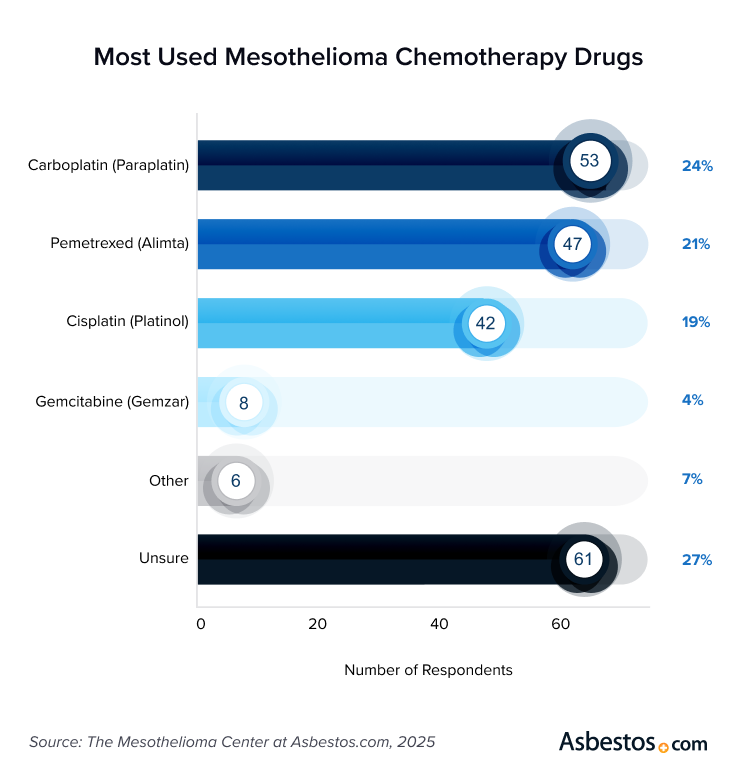
Our survey also shows the most common side effects of chemotherapy, regardless of the type of chemo drug used, included fatigue, nausea and chemo brain.

Carla Fasolo is a pleural mesothelioma survivor from Leesburg, Florida, who was diagnosed in 2021. She told us that fatigue impacted her day-to-day activities. “After having chemo, I became very, very tired, very lethargic,” Carla said. “It was hard not being able to keep up with my daily chores.”
Immunotherapy
Immunotherapy was part of the treatment plan for 22% of mesothelioma patients. Opdivo remained the most common immunotherapy drug, often paired with Yervoy as the newest approved immunotherapy combination for mesothelioma. Immunotherapy was 18% more common among the 83% of those who did not achieve remission.
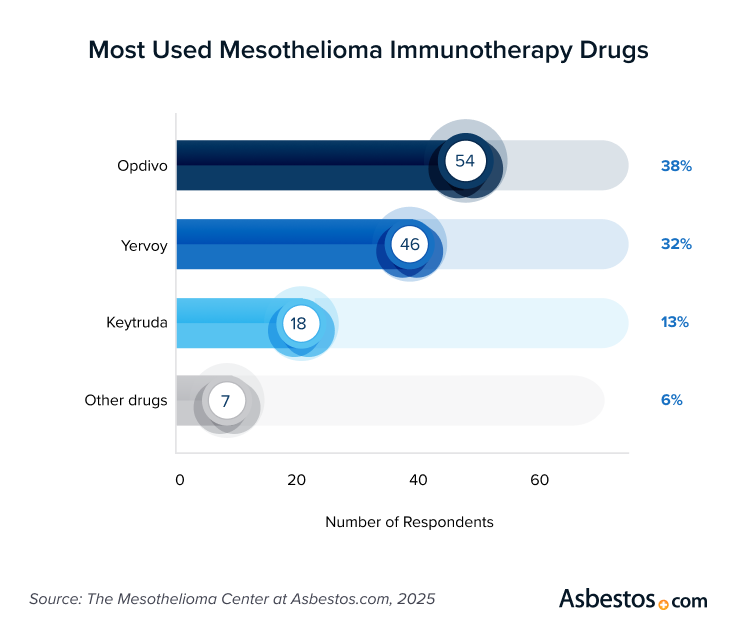
Among survey respondents, 16% reported fatigue as the most common immunotherapy side effect. Less frequent side effects included body aches, muscle pain, appetite loss and weight loss. These findings indicate that while immunotherapy is increasingly accessible, its effectiveness varies, and lack of energy remains a notable concern for patients.
Immunotherapy is a more targeted treatment than chemotherapy. The drug tends only to affect areas where cancer is present. Side effects are often less severe and more reversible than those associated with chemo drugs.
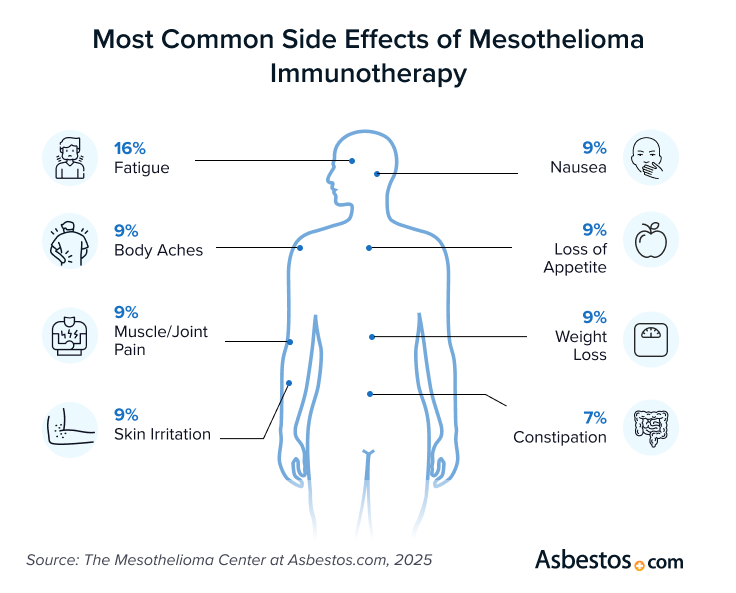
Surgery
Surgery was a key treatment for 19% of all mesothelioma patients. Among those who experienced remission, 23% had surgery, and among those who did not experience remission, 14% had surgery.
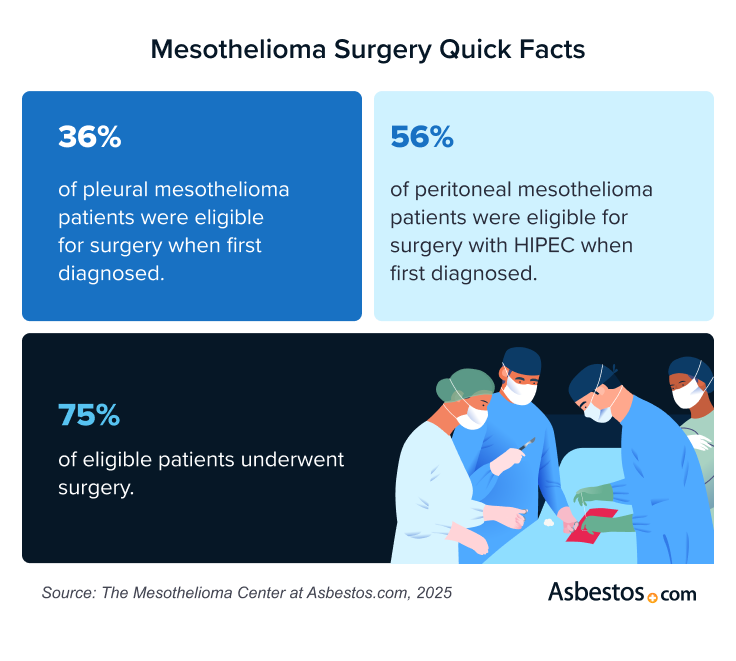
Despite the benefits of undergoing surgery, such as a close correlation with remission, 74% of eligible patients declined it. Barriers included age, comorbidities and perceived risk.
Pleural Mesothelioma Surgeries
- 57% had a pleurectomy and decortication (P/D)
- 11% had an extrapleural pneumonectomy (EPP)
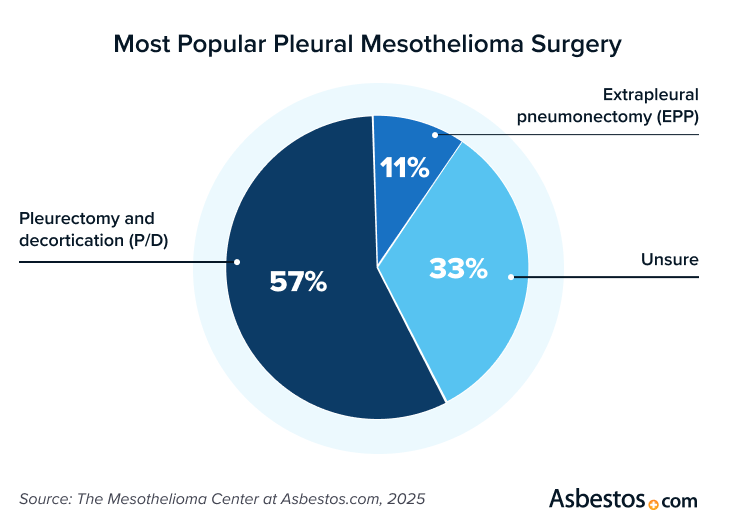
Less invasive surgeries like P/D continue to be preferred, especially when patients prioritize recovery time and quality of life. This procedure strips the pleural lining from the chest and removes tumor masses.
Some patients with extensive cancer may require an EPP, which also removes the entire affected lung, parts of the diaphragm and affected lymph nodes. This type of aggressive and invasive surgery may be too demanding for older patients or those with chronic illnesses.
Seeking or Not Seeking a Mesothelioma Specialist
Patient access to specialist care is crucial. Nearly 25% of survey respondents did not seek a mesothelioma specialist, and more than 10% were unsure if they had. Of those who achieved remission, 13% saw a specialist.
Specialists include doctors from multiple specialties trained in mesothelioma, including oncologists, surgeons and radiologists. Seeking a specialist opens access to the latest and best treatments for mesothelioma, including novel therapies through clinical trials.
Getting a second opinion is essential for cancer patients. You should feel safe with your provider and trust they offer the best options. That often means talking to two or more doctors at various cancer centers.
Among survey respondents, 34% saw three or more doctors, 39% saw two doctors and 20% saw one doctor other than their primary care physician.
A second opinion is vital because it lets you evaluate the pros and cons of working with specific cancer centers and their health care teams. If you’re unsure about the care you receive, it could jeopardize your health.

These figures suggest that patients benefit from second opinions and multidisciplinary evaluation. However, systemic or geographic limitations may prevent broader access to specialists.
Peritoneal mesothelioma survivor Tamron Little told The Mesothelioma Center that seeing a specialist changed the way she approached treatment.
“My experience going to a specialist was like night and day compared to a general doctor,” Little said. “Once I found the peritoneal mesothelioma specialist, he gave me the hope I needed because he knew just what to do and what treatment was best for me.”
Participation in Mesothelioma Clinical Trials
Participation in clinical trials in the U.S. remains limited. Only 8% of patients reported participating in a clinical trial, a 6 percentage-point drop from 2023. This low number points to ongoing gaps in patient outreach, eligibility, and access to emerging treatment options.
The oncologist didn’t think I’d last 30 days. I started Keytruda [in a clinical trial], and almost immediately things changed for the better. You could feel it. Something worked for me.
Research trials offer the latest experimental therapies, but patient distance or treatment center availability can be limiting factors. Lack of awareness is another significant reason for low clinical trial participation. Clinical trial participation numbers will decline in the coming years as the federal government cuts critical funding dedicated to ongoing and new cancer clinical trials.
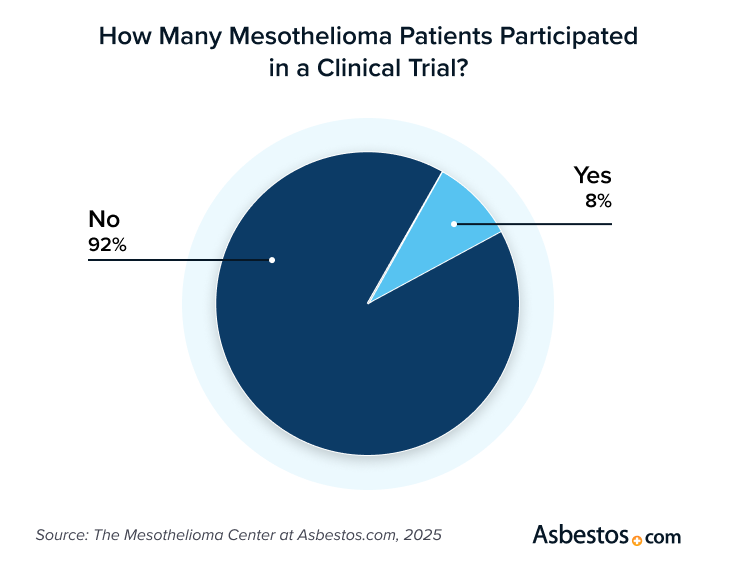
Younger Patients More Likely to Seek Alternative Treatments
Younger patients are more inclined to explore integrative care. Patients under 50 were 28% more likely to try alternative treatments than those 71–80.
The same group of patients under 50 are often more open to alternative treatments like medical marijuana and herbal medicine. They have better access to information online about new health options, allowing them to learn about various therapies for their health issues. This willingness to explore new treatments sets them apart from older generations.
What really got me through were the holistic things. I said, “I wonder if this is going to help me.” It wasn’t a cure-all, but it took the edge off. If anything, I just mentally felt better. It improved my well-being.
A 2025 study published in Frontiers in Public Health showed older patients often favor traditional treatments because they are accustomed to conventional medicine and trust these familiar practices. They may not pursue alternative therapies because of limited local options or a lack of knowledge. This difference illustrates how access to information influences treatment choices among different age groups.
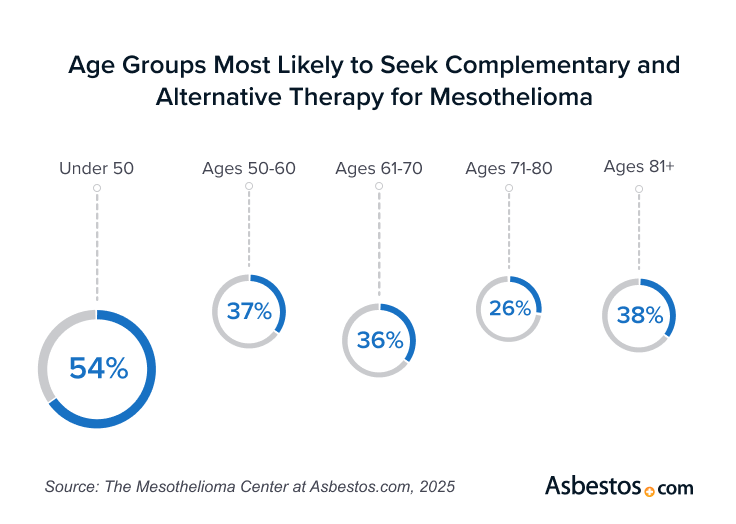
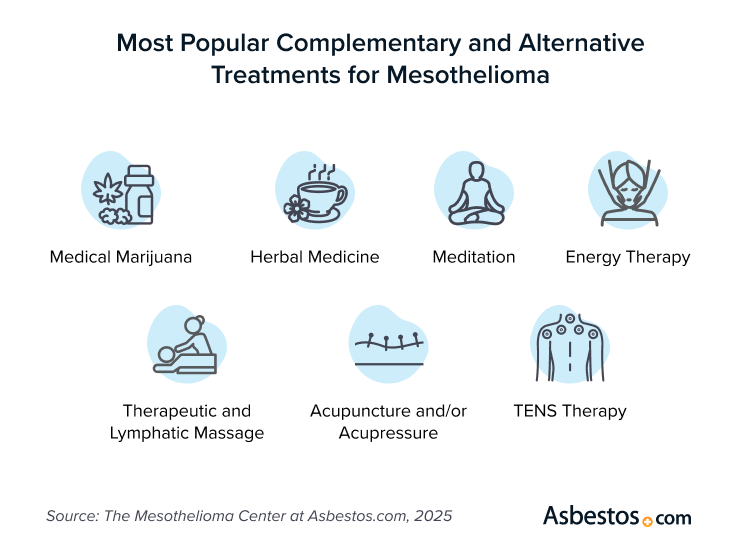
Most Common Alternative Treatment: Marijuana
Among the variety of alternative treatments reported, medical marijuana was the most frequently used. This finding supports cannabis-based treatments as a leading complementary therapy among younger mesothelioma patients.
Marijuana Usage
- 21% of patients under 50 used medical marijuana
- 7% of patients over 81 used acupuncture or acupressure
- 7% of patients over 81 used CBD oil
- 1% of patients aged 61–70 used IV vitamin C
- 1% of patients aged 61–70 used CBD oil pills
In a 2022 study published in Cancers, cannabis plants displayed some anti-cancer benefits for mesothelioma patients. Researchers found that cannabis compounds slowed mesothelioma cell growth in human and rat cells. While rat survival rates didn’t improve, further research may enhance drug delivery methods.

Despite High Mortality Rate, Only Half Seek Palliative Care
Access to comfort care remains uneven. Only 34% of pleural mesothelioma patients and 40% of peritoneal patients received palliative care.
Palliative care focuses on relieving symptoms and improving quality of life. It’s often less invasive than treatment that aims to cure the disease. Many doctors use it alongside standard therapy to control symptoms.

Examples of palliative care include bedside procedures, radiotherapy, chemotherapy and immunotherapy. A pleurocentesis can remove fluid in the chest. Palliative radiation therapy can slow the growth of tumors pressing on the lungs.

Many people confuse palliative care with hospice services. While palliative care relieves symptoms, hospice provides end-of-life care for terminally ill patients.
Hospice Usage
- 59% of participants said they or their loved ones never received hospice care
- Pleural mesothelioma patients were 21% more likely to use hospice than those with peritoneal disease
These findings highlight a critical gap in care. Increasing education about palliative and hospice options may improve end-of-life quality and reduce suffering.

Key Takeaways
Examining the state of mesothelioma patients and treatment access in 2025 allows us to look forward and improve outcomes for the future. For patients who experienced remission, 23% underwent surgery. This rate was 9% higher than those who did not have remission. Additionally, carboplatin was associated with a 72% higher remission rate among chemotherapy recipients.
Survey results also highlighted significant barriers to optimal care. Only 13% of patients who achieved remission had seen a mesothelioma specialist. Seeing a specialist leads to more treatment options and better outcomes, but roughly a third of mesothelioma patients did not see one.
These figures suggest that patients need more education and advocacy about expert-guided care. Just 8% of patients participated in a clinical trial, and less than half of them received palliative or hospice care.
Looking ahead, encouraging patients to see a specialist, consider surgery when eligible, participate in clinical trials and receive adequate palliative care is the most effective way to improve mesothelioma prognosis and survival. In 2025 and beyond, access, education and support remain foundational pillars for progress towards a mesothelioma cure.
Survey Methodology
As the nation’s most trusted mesothelioma resource, half of the people diagnosed with mesothelioma in the United States come to The Mesothelioma Center for help. We have served those affected by asbestos exposure for nearly two decades and continue to contribute new statistics for mesothelioma research.
The State of Mesothelioma: 2025 Survey Methodology
- 215 people answered the survey, all with a confirmed mesothelioma diagnosis or a loved one with one.
- The survey included 20+ questions and ran from February to March 2025.
- Survey invitations were exclusive to individuals who previously contacted The Mesothelioma Center.
We plan to run this survey annually to provide the mesothelioma community with reliable, up-to-date statistics. Building on meaningful data each year allows us to grow a long-term resource for mesothelioma patients, families, providers and caregivers.
The statistics in this report apply only to people diagnosed with various forms of mesothelioma and are not representative of the general population.





